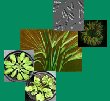| Bendix, J; Homeier, J; Cueva-Ortiz, E; Emck, P; Breckle, SW; Richter, M; Beck, E: Seasonality of weather and tree phenology in a tropical evergreen mountain rain forest., Int. J. Biometeorol., 50, 370-384 (2006), doi:DOI:10.1007/s00484-006-0029-8 | |
| Abstract: Flowering and fruiting as phenological events of 12 tree species in an evergreen tropical mountain rain forest in southern Ecuador were examined over a period of 3–4 years. Leaf shedding of two species was observed for 12 months. Parallel to the phenological recordings, meteorological parameters were monitored in detail and related to the flowering and fruiting activity of the trees. In spite of the perhumid climate of that area, a high degree of intra- and inter-specific synchronisation of phenological traits was apparent. With the exception of one species that flowered more or less continuously, two groups of trees could be observed, one of which flowered during the less humid months (September to October) while the second group started to initiate flowers towards the end of that phase and flowered during the heavy rains (April to July). As reflected by correlation coefficients, the all-time series of meteorological parameters showed a distinct seasonality of 8–12 months, apparently following the quasi-periodic oscillation of precipitation and related cloudiness. As revealed by power spectrum analysis and Markov persistence, rainfall and minimum temperature appear to be the only parameters with a periodicity free of long-term variations. The phenological events of most of the plant species showed a similar periodicity of 8–12 months, which followed the annual oscillation of relatively less and more humid periods and thus was in phase or in counter-phase with the oscillations of the meteorological parameters. Periods of unusual cold or dryness, presumably resulting from underlying longer-term trends or oscillations (such as ENSO), affected the homogeneity of quasi-12-month flowering events, fruit maturation and also the production of germinable seeds. Some species show underlying quasi-2-year-oscillations, for example that synchronise with the development of air temperature; others reveal an underlying decrease or increase in flowering activity over the observation period, influenced for instance by solar irradiance. As Ecuador suffers the highest rate of deforestation in South America, there is an urgent need for indigenous plant material for reforestation. A detailed knowledge of the biology of reproduction in relation to governing external factors (mainly climate) is thus required. |

Letzte Änderung 09.10.2020

